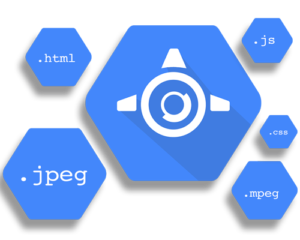Google App Engine
Google App Engine is a web application hosting service. By “web application,” we mean an application or service accessed over the Web, usually with a web browser: storefronts with shopping carts, social networking sites, multiplayer games, mobile applications, survey applications, project management, collaboration, publishing, and all the other things we’re discovering are good uses for the Web. App Engine can serve traditional website content too, such as documents and images, but the environment is especially designed for real-time dynamic applications. Of course, a web browser is merely one kind of client: web application infrastructure is well suited to mobile applications, as well.


The Runtime Environment
An App Engine application responds to web requests. A web request begins when a client, typically a user’s web browser, contacts the application with an HTTP request, such as to fetch a web page at a URL. When App Engine receives the request, it identifies the application from the domain name of the address, either a custom domain name you have registered and configured for use with the app, or an .appspot.com subdomain provided for free with every app. App Engine selects a server from many possible servers to handle the request, making its selection based on which server is most likely to provide a fast response. It then calls the application with the content of the HTTP request, receives the response data from the application, and returns the response to the client.
In the complete picture, App Engine allows runtime environments to outlive request handlers, and will reuse environments as much as possible to avoid unnecessary initialization. Each instance of your application has local memory for caching imported code and initialized data structures. App Engine creates and destroys instances as needed to accommodate your app’s traffic. If you enable the multithreading feature, a single instance can handle multiple requests concurrently, further utilizing its resources.
The Services
The datastore’s relationship with the runtime environment is that of a service: the application uses an API to access a separate system that manages all its own scaling needs separately from application instances. Google Cloud Platform and App Engine include several other self-scaling services useful for web applications. The memory cache (or memcache) service is a short-term key-value storage service. Its main advantage over the datastore is that it is fast, much faster than the datastore for simple storage and retrieval. The memcache stores values in memory instead of on disk for faster access. It is distributed like the datastore, so every request sees the same set of keys and values. However, it is not persistent like the datastore: if a server goes down, such as during a power failure, memory is erased. It also has a more limited sense of atomicity and transactionality than the datastore. As the name implies, the memcache service is best used as a cache for the results of frequently performed queries or calculations. The application checks for a cached value, and if the value isn’t there, it performs the query or calculation and stores the value in the cache for future use. Google Cloud Platform provides another storage service specifically for very large values, called Google Cloud Storage.[2] Your app can use Cloud Storage to store, manage, and serve large files, such as images, videos, or file downloads. Cloud Storage can also accept large files uploaded by users and offline processes.

